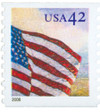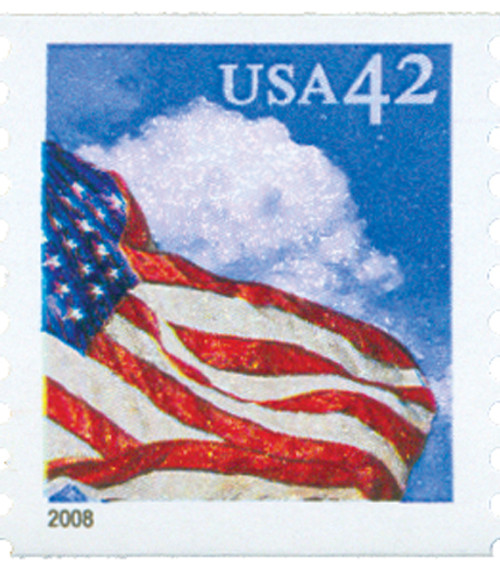
2008 42c Flags 24/7: Flag at Dawn w/a
# 4230 - 2008 42c Flags 24/7: Flag at Dawn w/a
$2.50 - $3.75
U.S. #4230
2008 42¢ Flag at Dawn
American Flags 24/7
Issue Date: April 18, 2008
City: Washington, DC
Printed By: American Packaging Corporation for Sennett Security Products
Printing Method: Photogravure
Perforations: 10
Color: Multicolored
In 2008, U.S. Postal Service issued a set of stamps titled American Flags 24/7, showing the American flag at different times of day. Three printers produced these flags in three different coil sizes. U.S. #4230 is part of a coil of 3,000 and has water activated gum.
The Stars and Stripes is the most recognizable symbol of American independence. Established in 1942, the Flag Code outlines the proper procedures for handling and displaying the American flag. When the flag is raised, normally at sunrise, it is to be hoisted quickly. In the military, the flag is raised at the start of the bugle call “Reveille,” and should be saluted.
When raising multiple flags, the American flag should be the first one raised. According to the Flag Code, the American flag should always be displayed in a place of prominence. Generally, it should be flown on its own right (the viewer’s left). The exception is in instances where there is a taller, middle pole, which is where the American flag should fly. Whenever the American flag is displayed, the Union (the blue field with the stars) should be on the viewer’s left. As a sign of respect to our nation, no other flag should fly above the American flag, and all national flags should be flown at the same height.
Because “this flag dips to no earthly king,” the American flag is never to be dipped to any person or thing. Out of respect, it must never touch the ground. In addition, it should never be flown upside down, unless it is being used as a distress signal.
U.S. #4230
2008 42¢ Flag at Dawn
American Flags 24/7
Issue Date: April 18, 2008
City: Washington, DC
Printed By: American Packaging Corporation for Sennett Security Products
Printing Method: Photogravure
Perforations: 10
Color: Multicolored
In 2008, U.S. Postal Service issued a set of stamps titled American Flags 24/7, showing the American flag at different times of day. Three printers produced these flags in three different coil sizes. U.S. #4230 is part of a coil of 3,000 and has water activated gum.
The Stars and Stripes is the most recognizable symbol of American independence. Established in 1942, the Flag Code outlines the proper procedures for handling and displaying the American flag. When the flag is raised, normally at sunrise, it is to be hoisted quickly. In the military, the flag is raised at the start of the bugle call “Reveille,” and should be saluted.
When raising multiple flags, the American flag should be the first one raised. According to the Flag Code, the American flag should always be displayed in a place of prominence. Generally, it should be flown on its own right (the viewer’s left). The exception is in instances where there is a taller, middle pole, which is where the American flag should fly. Whenever the American flag is displayed, the Union (the blue field with the stars) should be on the viewer’s left. As a sign of respect to our nation, no other flag should fly above the American flag, and all national flags should be flown at the same height.
Because “this flag dips to no earthly king,” the American flag is never to be dipped to any person or thing. Out of respect, it must never touch the ground. In addition, it should never be flown upside down, unless it is being used as a distress signal.









